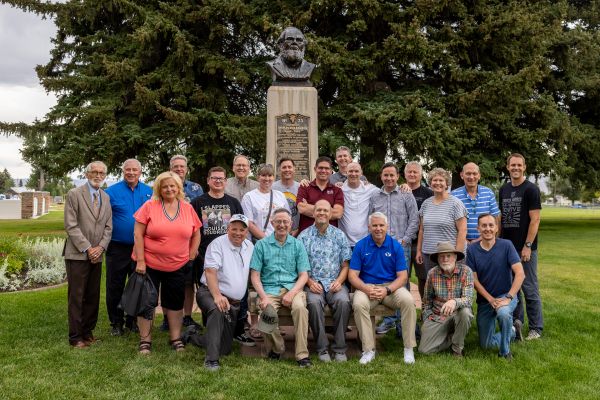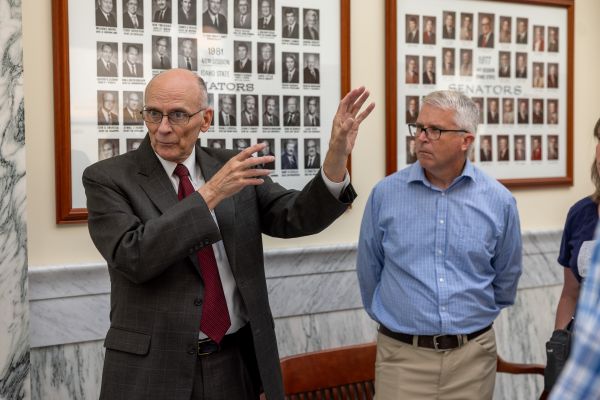Idaho Regional Studies in Church History
A Journey Through Sacred Landscapes
R. Devan Jensen and Alexander L. Baugh
R. Devan Jensen (devan_jensen@byu.edu) is the executive editor at the Religious Studies Center.
Alexander L. Baugh (alex_baugh@byu.edu) is a professor of Church history at Brigham Young University.
The year 2025 marked a milestone in Idaho as the state’s population surpassed the two million mark (2,032,120). Significantly, Latter-day Saint membership in the state numbers 481,049, representing nearly 24 percent of the population and making it just behind Utah and California in the number of Church members. Currently there are 142 stakes, 1,224 wards, fifty branches, three missions, six operating temples, and another five under construction or recently announced.
Beginning in 1860, the influence of the Latter-day Saints in Idaho, both past and present, has been nothing short of monumental. To learn more about that history, from July 28 to August 3, faculty members from the Department of Church History and Doctrine at BYU and BYU–Idaho embarked on an intensive and educational tour of historical sites across Idaho. The Idaho Regional Studies in Church History Tour aimed to deepen understanding of the unfolding history of The Church of Jesus Christ of Latter-day Saints, pioneer settlements, Indigenous cultures, and the Oregon Trail in the Gem State. The journey blended spiritual insight, scholarly discussion, and historical reflection as participants visited cemeteries, homes, monuments, museums, sacred edifices, and historic buildings and landmarks.
Monday, July 28—Franklin County: Legacy and Landscape in the Church’s First Idaho Settlement
The tour began in Franklin, Idaho, settled by the Latter-day Saints in 1860 and the state’s oldest permanent settlement. Faculty members visited the Lorenzo Hill Hatch home and Franklin Relic Hall Museum, where Susan and Shawnee Hawkes discussed the legacy of early Church members and their leaders.
In nearby Whitney, Sherilyn Farnes provided background on the life of Church President Ezra Taft Benson, including his boyhood home and burial site. A stop in Preston highlighted the birthplace of Apostle Matthew Cowley, with commentary by Mark Ogletree, and the historic Oneida Stake Academy, presented by Scott Esplin, Fred Woods, and local historian Necia Seamons. While in Preston, faculty paused at Preston High School, made famous by the cult classic Napoleon Dynamite. Nearby, they visited homes connected to the fictional characters Pedro Sanchez and Napoleon Dynamite, adding a light cultural note to a day rich in history.
A solemn and significant stop followed: the Bear River Massacre sites, where Ken Alford and Shoshone leader Darren Parry recounted the tragic events of January 1863 when US troops under the leadership of Col. Patrick E. Connor killed over four hundred Northwestern Shoshone men, women, and children. Parry emphasized the importance of the land’s original stewards and their enduring presence in the region.
The tour continued to Red Rock Pass, where Devan Jensen explained that the pass was the epicenter of the Bonneville Flood. Water from Lake Bonneville burst through at a peak flow rate three times greater than the Amazon River. Tucked behind the pass lies a quiet cemetery where Captain Jefferson Hunt, a Mormon Battalion leader, explorer, and settler of several Utah and Idaho towns, is buried and remembered with reverence.
Additional visits included the President Harold B. Lee memorial in Clifton, with remarks by Stephanie Sorensen, and a short jaunt over the Utah-Idaho border to visit the Three Witnesses monument in the Clarkston, Utah, cemetery, where Robert Smith paid tribute to Martin Harris, who was the last surviving witness to the Book of Mormon.
Tuesday, July 29—Bear Lake County: Tabernacles and Trails
The next leg took the group to Bear Lake County, passing through St. Charles, Idaho, the birthplace of sculptor Gutzon Borglum, famed for Mount Rushmore in South Dakota and Stone Mountain in Georgia.
In Paris, Idaho, participants explored the renowned Bear Lake Stake Tabernacle, designed by John Don Carlos Young, son of Brigham Young, and constructed under the direction of Apostle Charles C. Rich, whose monument stands nearby. Presentations by local historians LaMar Merrill and Spencer and Laurie Rich honored the tabernacle and Rich’s pioneering spirit and leadership.
Later, the group traveled to Montpelier to tour the National Oregon and California Trail Center, where they experienced firsthand the hardships and hopes of westward migration. A visit to the Montpelier Tabernacle, with its historic Minerva Teichert murals, gave insight into faith and art in early twentieth-century worship, with insights from professor and artist Anthony Sweat.
Craig Manscill led presentations in Soda Springs on the Morrisite historical markers—a reminder of schismatic divisions during the early Utah period—and the graves of Morrisite leader Neils Anderson and his wife Mary Christofferson, who led the Morrisite followers in Soda Springs. The group then viewed the famed Soda Springs Geyser.
 Local guides LaMar Merrill (back, left) and Spencer Rich (front, second from right) led a tour of the Bear Lake Stake Tabernacle and gathered at the Charles C. Rich monument. Photo by Richard B. Crookston.
Local guides LaMar Merrill (back, left) and Spencer Rich (front, second from right) led a tour of the Bear Lake Stake Tabernacle and gathered at the Charles C. Rich monument. Photo by Richard B. Crookston.
Wednesday, July 30—Eastern Idaho: Temples, Tribes, and Tubers
Eastern Idaho opened with a tour of the Fort Hall replica and Bannock County Historical Museum in Pocatello, showcasing the fur trade and Indigenous history of the region. The group also visited the Pocatello Idaho Temple, where Travis Searle and Ryan Gardner discussed initial opposition to the Latter-day Saints there and how the temple open house and dedication were followed by positive outreach efforts of the Portneuf Interfaith Fellowship toward the Latter-day Saints.
 State Senator C. Scott Grow leads faculty on a tour of the Idaho State Capitol. Photo by Richard B. Crookston.
State Senator C. Scott Grow leads faculty on a tour of the Idaho State Capitol. Photo by Richard B. Crookston.
In Blackfoot the scholars explored a unique stop: the Idaho Potato Museum. The museum celebrated Idaho’s agricultural legacy, giving a nod to the state’s most iconic crop.
At the Idaho Falls Idaho Temple and Visitors’ Center, Elder John H. Groberg, emeritus General Authority Seventy, shared personal insights on Pacific missionary work, temple history, and his service as temple president. Maclane Heward supplemented with reflections on the temple’s construction and impact. Mary Jane Woodger shared details about Gutzom Borglum’s early Church upbringing and his landmark sculptures. The day concluded with an endowment session in the Rexburg Idaho Temple. (The Teton River Idaho Temple is being built three miles north on the same road. Both will serve the Saints of the Upper Snake River Valley.)
Thursday, July 31—Sugar City: Tragedy and Triumph
Thursday began with a visit to Thomas C. Neibaur Veterans Park in Sugar City, where Brian Mead discussed Neibaur’s valor in WWI, resulting in his being the first Latter-day Saint to be awarded the Congressional Medal of Honor. From there, Roger Wiblin guided a sobering tour of the Teton Dam, site of one of the darkest chapters in Idaho’s modern history, when the catastrophic dam failure in June 1976 flooded entire communities. The site served as a powerful reminder of both human vulnerability and resilience.
Friday, August 1—Rexburg to Boise: Memory and Monument
Back in Rexburg, the group convened with BYU–Idaho Religious Education faculty to discuss shared educational goals. Jake Romney presented on BYU–Pathway Worldwide, emphasizing the Church’s global educational outreach. John Thomas and university archivist Adam Luke highlighted the legacy of Thomas E. Ricks, a local foundational educational figure.
Documentary film director Christian Mawlam and producer Fred Woods led a discussion of their documentary Flood of Memories at Rexburg’s downtown Romance Theater that provided firsthand survivor accounts of the Teton Dam flood, contextualizing the previous day’s site visit.
En route to Boise, the group then drove to Goodale’s Cutoff on the old Oregon Trail Route (Highway 20) and visited the dramatic lava fields of Craters of the Moon National Monument.
Saturday, August 2—Boise: Capitol, Conviction, and Community
 David Leroy, attorney and former lieutenant governor of Idaho, donated a vast array of priceless Lincoln artifacts to the Idaho State Archives. Photo by Richard B. Crookston.
David Leroy, attorney and former lieutenant governor of Idaho, donated a vast array of priceless Lincoln artifacts to the Idaho State Archives. Photo by Richard B. Crookston.
In Boise, Angie Davis of the Idaho State Archives shared documents related to Latter-day Saints in Idaho, and David Leroy, a former Idaho state attorney general, lieutenant governor, and Abraham Lincoln artifact collector, gave an in-depth presentation on Lincoln’s legacy in the creation of the Idaho Territory and on early Idaho governance. Fred Woods presented on the forty-eight Latter-day Saint men incarcerated at the Old Idaho State Penitentiary between 1885 and 1890 for unlawful cohabitation. The group then toured the historic prison.
Stephen W. Kenyon, president of the Boise East Stake and formerly the clerk of the Idaho Supreme Court, discussed the political legacy of Peter Pefley, a member of Idaho’s Constitutional Convention who refused to sign the Constitution because of the Idaho Test Oath that disenfranchised the Latter-day Saints from voting.
At the Idaho State Capitol, State Senator C. Scott Grow, an emeritus General Authority Seventy, offered a tour and discussed the current state of Idaho politics and the integration of Latter-day Saint values in public life. The group then visited the Boise homesites of Presidents Howard W. Hunter and Ezra Taft Benson, tracing the roots of two influential Church Presidents.
Sunday, August 3—Sacred Spaces and Final Reflections
The tour concluded at the Boise Idaho Temple, where Derek Sainsbury offered reflections on the religious dynamics of the Latter-day Saints in the Boise area and where Philip Allred discussed the spiritual legacy of William M. and Orissa Allred, early settlers in St. Charles.
The 2025 Idaho Regional Studies in Church History Tour revealed that history lives not just in dusty books or museum cases but in the land itself—in rivers and valleys, farms and communities, schools and churches—and most of all in the day-to-day lives of its people. From the vastly different perspectives of the many different types of people, religions, and cultures who call Idaho home, the participants gained a fuller understanding of Idaho’s complex and sacred past.
This weeklong pilgrimage of learning and remembrance brought scholars into deeper contact with the region’s layered heritage, reminding them—and all of us—that history is never far from where we stand.
Regional Studies in Church History Tours | |
| 1985 | New England |
| 1986 | Arizona |
| 1987 | British Isles |
| 1988 | New York |
| 1989 | Ohio |
| 1991 | Missouri |
| 1993 | Illinois |
| 1996 | California |
| 1998 | Western Canada |
| 1999 | New York and Pennsylvania |
| 2000 | Europe |
| 2002 | New England |
| 2004 | Ohio and Upper Canada |
| 2006 | 20th-Century Great Britain |
| 2008 | Pacific Isles |
| 2010 | Salt Lake City |
| 2012 | Mormon Trail |
| 2019 | Washington, DC |
| 2025 | Idaho |
